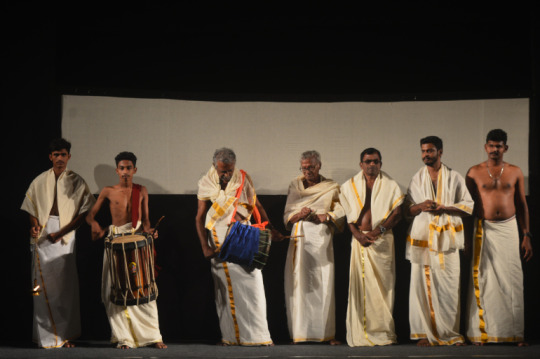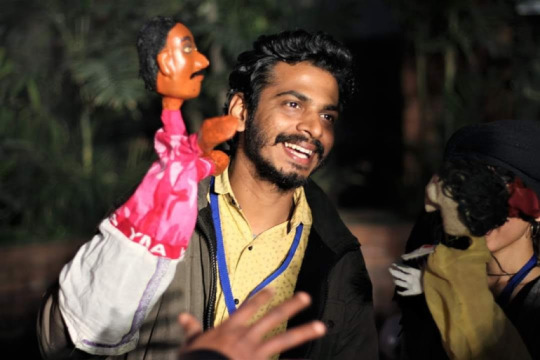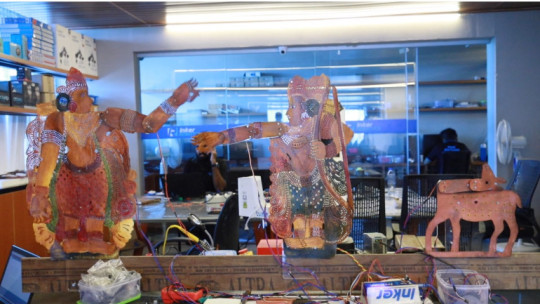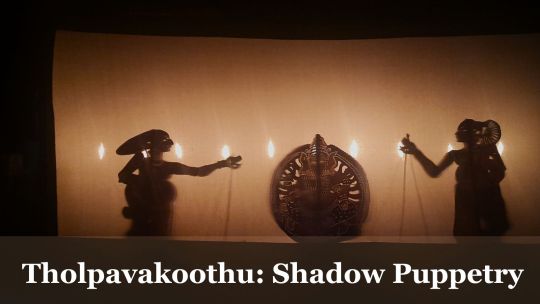#Tholpavakoothu
Photo

Tholpavakoothu- Shadow puppetry .From macro to wide shot with new Fujifilm XF-30mm lens on an XH2 body #artform #tholpavakoothu #keralaart #fujifilmxf30mm #fujifilmxindia #fujifixh2 #lowlightphotography #macrophoto #shadowpuppetry #fujifilmglobal #fire #lowlightphoto #keralamoodygram #keralagram #artforms #fujilovers #nightphotography #entethrissur (at Gulfu Photography) https://www.instagram.com/p/ClbVSgEv2Bo/?igshid=NGJjMDIxMWI=
#artform#tholpavakoothu#keralaart#fujifilmxf30mm#fujifilmxindia#fujifixh2#lowlightphotography#macrophoto#shadowpuppetry#fujifilmglobal#fire#lowlightphoto#keralamoodygram#keralagram#artforms#fujilovers#nightphotography#entethrissur
0 notes
Photo

(via Shadow Puppetry in Kerala: The Traditional Art of Tholpavakoothu)
0 notes
Text
INTACH’s Palakkad chapter is documenting the green heritage of the district
INTACH’s Palakkad chapter is documenting the green heritage of the district
‘Marangalum Naattile Kathakalum’ traces interesting stories woven around the grand old trees in villages in Palakkad, including the banyan where OV Vijayan’s novel Khasakkinte Itihasam begins. Today is World Heritage Day
‘Marangalum Naattile Kathakalum’ traces interesting stories woven around the grand old trees in villages in Palakkad, including the banyan where OV Vijayan’s novel Khasakkinte…

View On WordPress
#Environment#greenery#INTACH#Kerala#OV Vijayan#Palakkad#THiruvananthapuram#Tholpavakoothu#world heritage day
0 notes
Text
Socio-economic history of Kerala
Socio-economic history of Kerala
Socio-economic history of Kerala: Padmashri recipient focuses on socio-political issues and content topics through ancient art forms
The art form of hundreds of people in Kerala, Thorapavakattu (shadow puppet) takes away the past and present from the promise of a time and presents the story of the seat in the state. The Kollamavattu event of KK Ramachandra Puluvar is a part of Choir Kerala 2021…
View On WordPress
#&039;Kamba Ramayana&039;#Coir Fest#COVID-19#KK Ramachandra Pulavar#mahabharata#Padma Shri#Panchatantra#Pinarayi Vijayan#shadow puppetry#tholpavakoothu#Thomas Isaac#Thrissur
0 notes
Photo

KK Ramachandra Pulavar expands the scope of ‘tholpavakoothu’
#039KambaRamayana039#CoirFest#covid19#KKRamachandraPulavar#Mahabharata#PadmaShri#Panchatantra#PinarayiVijayan#shadowpuppetry#tholpavakoothu#ThomasIsaac#thrissur
0 notes
Text
Kerala’s ‘Tholpavakoothu’ in a modern avatar in a music video
Kerala’s ‘Tholpavakoothu’ in a modern avatar in a music video
[ad_1]
The use of Kerala’s traditional puppetry in a music video by director Emcy Joseph throws open a world of possibilities for the art form
Kochi’s metro train gliding over tracks, a traffic signal, the Biennale, a Royal Enfield motorcycle or for that matter a football match do not feature in Tholpavakoothu, a form of shadow puppetry traditionally performed in Kerala temples. Director and…
View On WordPress
0 notes
Text
Most Famous Traditional Art Forms of Kerala.

Kerala is known for traditional arts,cultural forms and sometime reffered as land of festivals. There are various communities in Kerala who contribute diverse forms of performing arts and colorful culture.
Here is the list of traditional and classical art forms of Kerala including Panchavadyam, Nangiar Koothu, Krishnanattam, Ottamthullal, Mohiniyattam, Theeyaattam, Tholpavakoothu, Poothan and…
View On WordPress
1 note
·
View note
Video
As India celebrates #Diwali, the festival of lights, here's a look at one (of many) Indian ritual/folk art forms that is totally dependent on light. 'Thol-pava-koothu' is a ritual art form performed in or near Goddess temples in and around #Palakkad district (Central Kerala). Oil is filled in coconuts and then lit up. 'Thol' means leather, 'Pava' means puppet and 'Koothu' means play. Tholpavakoothu is thus the staging of plays with leather puppets. Modern versions last a few hours, however elaborate ritualistic versions can last up to 42 days! The light from these art forms though are on the verge of getting extinguished, forever, unless you and me pitch in. This is true of the hundreds of art forms across India. How about visiting or inviting one of these performers for your next Company event or at your residential associations upcoming New Year party or maybe even your, or a close ones, wedding party. It can have a huge impact. Think about it. You can also enquire locally and visit these artistes when on a holiday. Let's do whatever little we can while its still possible. Happy Diwali to all of you and to your loved ones. :-) #tholpavakoothu #ritualarts #folkarts #soundsofmalabar #corporateevents #weddingideas #indianrituals #indianfolkart #specialinteresttours #diwalispecial #deepavali https://www.instagram.com/p/BpzTruanoIc/?utm_source=ig_tumblr_share&igshid=x5jhtnvobg4t
#diwali#palakkad#tholpavakoothu#ritualarts#folkarts#soundsofmalabar#corporateevents#weddingideas#indianrituals#indianfolkart#specialinteresttours#diwalispecial#deepavali
0 notes
Text
Technology meets tradition: Kerala’s robotic leather puppets
Technology meets tradition: Kerala’s robotic leather puppets
Koonathara, Palakkad – A cool breeze, soulful prayer verses and eye-catching puppetry mesmerise the 25-plus audience sitting in chairs under the night sky of Koonathara, a village in Palakkad district in Kerala, India. They are a mix of locals and tourists from all over the world.
Tholpavakoothu (thol meaning leather, pava meaning puppet and koothu meaning play) is a form of shadow puppetry…

View On WordPress
#Arts and Culture#Asia#Features#India#Keralas#Latest Asia News#leather#Meets#puppets#robotic#Technology#tradition
0 notes
Text
Technology meets tradition: Kerala’s robotic leather puppets
New Post has been published on https://uspost.xyz/?p=34
Technology meets tradition: Kerala’s robotic leather puppets

Koonathara, Palakkad – A cool breeze, soulful prayer verses and eye-catching puppetry mesmerise the 25-plus audience sitting in chairs under the night sky of Koonathara, a village in Palakkad district in Kerala, India. They are a mix of locals and tourists from all over the world.
Tholpavakoothu (thol meaning leather, pava meaning puppet and koothu meaning play) is a form of shadow puppetry performed during events and festivals held in the temples dedicated to the goddesses Durga or Kaali. The artform is found only in Palakkad, Thrissur and neighbouring villages in Kerala.
Performed three to four times a month between January and May, a 42-foot-long special stage called koothumadam is set up in the temple premises. It displays mythological figures backlit by fire or lights behind a screen.
The festive air is palpable as a rhythmic drum beat begins and the performers emerge carrying a lighted lamp. Fireworks go off to announce the start of the performance and then, in total darkness except for the light of the lamp, a sense of calmness prevails.
A row of 21 wicks placed in coconut shells are lit behind the screen, made up of a white cloth stretched across the koothumadam, bordered by a black cloth.
Tholpavakoothu is based on Kamba Ramayana (the Tamil version of the epic Ramayana), which tells the story of the Hindu God Sri Rama from his birth to his coronation as the king of Ayodhya.
It is said that tholpavakoothu is performed to please the Goddess Bhadrakali, as she could not witness the slaying of the demon king Ravana by Rama, which is why an idol of the goddess is placed on a pedestal in front of the stage.

A view of the puppets from behind the screen [Photo courtesy of Sajeesh Pulavar]
About 160 puppets are used to represent the 70-odd characters of Kamba Ramayana, narrated in diction which is a mix of Malayalam and Tamil, with songs and poetry called Adalpattu.
Ten artists – the master puppeteer, singers, storytellers and other puppeteers – are highly skilled in the artform.
Sixty-two-year-old Lakshman Pulavar is one of them. He has been performing since he was a child, following in the footsteps of his father, grandfather, and those before them.
His family are the sole keepers of the 300-year-old artform, and have been performing it for eight generations.
The master puppeteer is called the “pulavan”, which derives from their family name Pulavar, meaning learned scholar.
The leather puppets, which are approximately 80cm in height, are made by Lakshman and his sons, with help from other family members. They are cut out from the hides of buffalo and deerskin, painted with vegetable dyes and fastened with sticks.
Manipulating them requires dexterity and concentration and is one of the most difficult parts of the performance, in which a total of 2,100 slokas (verses) and their meanings must also be memorised.

A performance team in front of a stage [Sajeesh Pulavar/Al Jazeera]
In total, the Pulavar family perform at 82 temples across Palakkad, with Lakshman and his sons responsible for 20 temples, and his brothers and cousins covering the rest.
The performance normally lasts for 21 days around the Pooram, the annual festival which falls in the first week of April, but can last even longer. The family also performs other shows in which different stories are told at events and functions around Palakkad. These performances are shorter, some lasting just 30 minutes, and require fewer artists.
“Artists have to undergo years of rigorous training before mastering this art form,” explains Lakshman, who is in the middle of training some students and holds a puppet in his hand as he speaks. “It took me a long time to recite all the verses verbatim,” he adds.
‘I love being a part of it’
The Harisree Kannan Tholpavakoothu Kalakendram at Koonathara is an institute dedicated to tholpavakoothu performances and is run by Lakshman and his sons, 31-year-old Sajeesh and 22-year-old Sajith.
The institute organises training sessions and summer camps to teach the artform, as well as how to make the puppets, training 10 to 20 adult students and 150 to 200 schoolchildren at any given time. They also conduct workshops for international students studying Indian culture. Since the pandemic, Sajeesh has been giving online classes using a makeshift stage in his house.

Lakshman Pulavar at a training session with his students [Sajeesh Pulavar/Al Jazeera]
“The drum beats and music add a sense of euphoria and excitement to the performance, and I love being a part of it,” says Sajith, his eyes sparkling as he speaks.
His brother Sajeesh left the village to study mechanical engineering and to work for an automobile firm, but soon returned to continue the family tradition.
“I have learnt the art of tholpavakoothu from my father and grandfather since the age of six and have been involved in this family tradition since my childhood,” he says.
Lakshman and his sons are passionate about the art form and dedicated to preserving it.
But since the COVID-19 pandemic began, the family has been struggling.
Due to restrictions, the duration of performances has been reduced from seven or eight hours a day to just four, and fewer people attend. During periods of lockdown, performances stop altogether. The lack of tourism in the past year has also meant smaller audiences.
Before the pandemic, they would make 150,000-200,000 rupees ($2,057-$2,744) a month for temple performances. Now they make 50,000-60,000 rupees ($686-$823) per month. But each show costs 20,000-35,000 rupees ($274-$480) to put on – and what is left from their earnings must be divided between the eight to 10 people involved in each production.
With fewer live performances, the Pulavars depend on online workshops to supplement their income. They have also started renting out their puppets, selling puppets to tourists and have even taken up farming. “We are cultivating rice to add to our income,” explains Lakshman.

Sajeesh Pulavar with a glove puppet [Sajeesh Pulavar/Al Jazeera]
Technology meets tradition
Another issue the family has encountered is a dwindling lack of interest in the art form among younger generations. But technology may be coming to the rescue in that regard.
Thrissur-based Inker Robotics is a tech startup founded in 2018 by 38-year-old Rahul Balachandran. It trains school and college students in automation and robotics, as well as developing robots to work in agriculture, industry and other areas.
A few years ago, after seeing the amount of work involved in manipulating the puppets, Rahul suggested the Pulavars try using robots to operate the puppets.
Sajeesh and Lakshman were instantly attracted to the idea, as they believed introducing something so modern to this traditional art form would attract more people to it.
“We were hoping to create awareness about preserving native traditions and culture,” Lakshman explains.
But as each robot would cost several hundred thousand rupees, they could not afford it.
Then, a few months ago, the District Heritage Museum in Palakkad, which hosts one of India’s largest collections of musical instruments, approached Sajeesh. It wanted to host a permanent tholpavakoothu puppet exhibit. Sajeesh saw an opportunity to use the robot-operated puppets and spoke to Rahul.
Together, they set about creating the first robot-operated puppet show. Sajeesh demonstrated the hand movements to Rahul and his team, who in turn wrote the code to synchronise the movements.

Testing the operation of robot puppetry at Inker Robotics [Photo courtesy of Rahul Balachandran]
“Sajeesh and I would brainstorm for hours with my team to bring out the best performance by the robots so that it reflects the original style of puppetry,” Rahul explains.
It took three months to complete.
It went on show for the first time in front of 100 people at the museum in February.
“People were amazed and excited to see the robot-operated puppet show as it was a new experience for them,” says Milton Francis, the director of the museum.
The puppets are programmed so that when a sensor detects the presence of a visitor it plays one of the stories from Kamba Ramayana, lasting between 30 minutes to two hours. It has been a huge hit since its installation and attracted large crowds before the most recent lockdown.
“The robot will be controlling the limb movements of the puppets which is the most difficult part,” says Sajeesh, adding: “It felt surreal seeing the robot manipulating the puppets, it was like a dream come true.”

Lakshman and Sajeesh Pulavar check out the exhibit at the museum [Photo courtesy of Sajeesh Pulavar]
Now they are considering new places in which to use the robots.
“We have used a prototype in the museum and are working on the product to install it at the Kochi airport which has a huge footfall,” says Rahul. “I am excited about the prospects of technology and its reach.”
But, despite the success of the robot-operated puppets, the Pulavars don’t want to lose the human touch and have decided to limit their use to stage performances while keeping the traditional hand-operated puppets for temple performances out of respect for the “beliefs and traditions of our elders”.
“We feel that such traditional art forms should be spread and taught to the younger generations, to see that they don’t go extinct,” says Lakshman.
0 notes
Text
Shadow Puppetry in Kerala: The Traditional Art of Tholpavakoothu
Tholpavakoothu is a mesmerizing shadow puppetry art form that originates from the culturally rich state of Kerala in southern India. With its roots deeply intertwined with Kerala’s history and traditions, Tholpavakoothu has been captivating audiences for centuries. This ancient art form combines the enchanting interplay of light and shadow, intricate leather puppets, and traditional storytelling…

View On WordPress
0 notes
Text
Watch | How Tholpavakoothu, the traditional puppetry of Kerala, emerged out of the shadows
Watch | How Tholpavakoothu, the traditional puppetry of Kerala, emerged out of the shadows
A video on tholpavakoothu, a centuries-old shadow puppetry tradition inherent to Kerala
Tholpavakoothu is believed to be more than 350 years old.
Performed in the Bhadrakali temples, from January to June every year, the shadow puppeteers of Kerala are busy performing the story of the Ramayana as part of the rituals during temple festivals.
Ramachandra Pulavar, son of the late guru KL…
View On WordPress
0 notes
Photo

Kerala’s ‘Tholpavakoothu’ in a contemporary avatar in a music videohttps://www.newszada.com/wp-content/uploads/2020/10/Keralas-‘Tholpavakoothu-in-a-modern-avatar-in-a-music-video.jpeg The use of Kerala’s conventional puppe...https://www.newszada.com/keralas-tholpavakoothu-in-a-contemporary-avatar-in-a-music-video/?feed_id=512019&_unique_id=5f85306c5fe34
0 notes
Photo

(via Tholpavakoothu, as marionetas em Querala | Índia)
0 notes
Video
vimeo
Yene Fikir, Ethiopia Official Trailer - #MECCAconIFF2019 official selection from Maia Crown Williams on Vimeo.
Set in 1970's Ethiopia during a time of violent political uprising-- Yene Fikir, Ethiopia, follows the turbulent and mystical journey of a young girl searching for freedom after being separated from her family. As she embarks on a painful migration through the scorching desert, magical guardian angels are sent to aid her by a mysterious and ancient Goddess in the skies, holding the secret to heal her homeland. With the presence of her angels, and her krar, she discovers hidden powers within herself she was unaware of before.
Gabrielle TesfayeDirector
Gabrielle TesfayeAnimator
Tensae FayiseMusical Composer
Haile SupremeMusic Composer
Director Biography - Gabrielle Tesfay
Gabrielle Tesfaye is an interdisciplinary artist versed in painting, animation, film, puppetry and interactive installation. Tesfaye is raised in America as a first-generation, to an Ethiopian father and mixed-heritage Jamaican mother. Her extensive international travel and exposure to multiculturalism in her life, echoes itself in her mixed media approach to art making and cross-cultural content. Her research is rooted in African diaspora, Afro-futurism, ancient puppetry practices and cultural storytelling.
Her background in film started at the Fashion Institute of Technology in New York City, and continued at the Mahidol University International College in Bangkok, Thailand. Tesfaye obtained her Bachelor of Fine Arts from Peck School of the Arts, at the University of Wisconsin-Milwaukee. Tesfaye has been internationally recognized in online and printed publications such as Majestic Disorder Magazine (UK) and Vogue (USA). Tesfaye has exhibited at The Crypt Gallery (London), Gallery X (Dublin), and Thapae East Venue for Creative Arts (Thailand)/
She is the recipient of a series of scholarships and awards, including two Frederick R. Layton Scholarships, Robert A. Nelson Film Scholarship, Cream City Cinema College Filmmaker Award, and Mary Nohl Suitcase Export Fund. Tesfaye has participated in multiple artist residencies including Tholpavakoothu Puppetry Theatre in Kerala, India, Art Residency Thailand in Chiang Mai, Thailand. Within her teaching experience, Tesfaye has explored the use of cultural storytelling and puppetry as community public art. Tesfaye is currently expanding with her art through international travel, film and guest speaking at schools, universities and artistic organizations.
"Yene Fikir, Ethiopia, meaning ‘My Love, Ethiopia’, takes us on a journey of a young girl escaping 1970's Ethiopia during a time of rising political conflict. Through live action and stop motion animation, the story is unveiled through turbulent migration, visiting spirits from an ancient world, and present day Ethiopia.
Ethiopia is proudly known as the country in Africa that wasn’t colonized, basking in untouched rich history and cultural traditions. However in more recent times, the country has also experienced political tyranny after the overthrow and death of King Haile Selassie. This has created a huge population of refugees fleeing the country, and the Ethiopian diaspora. Immigration is a pressing topic in current politics. The inner landscapes of emotional and mental psyches existing within the realm of leaving one’s country of birth, to start life in an afar land, is cryptic and not commonly understood. This film aims to reveal the story of these inner turmoils, providing African diaspora communities an expression of themselves not seen in current media. However, this film is not a disaster narrative supporting the seemingly small portrait past media outlets have tried to paint of the country, as a famished land. This films serves to express history, both modern and extremely ancient, and give Ethiopians an expression of themselves which encompass all of what we are- Magical. Power. Overcoming of all."
1 note
·
View note
Video
youtube
Plantações de Chá na Índia! 🍵 Tea plantations in Munnar! Imersão no mundo do chá indiano: visita à fábrica de chá Lockhart Tea Museum e passeio pelas plantações em Munnar! Depois, vamos descobrir mais sobre a cultura de Kerala: Kathakali (teatro) e Tholpavakoothu (teatro de sombras). Encontre seu hotel em Kerala aqui: http://bit.ly/2GjjLha! Você não paga mais por isso e ainda me ajuda a viajar mais e trazer mais dicas para cá! ;) Images: Luli Monteleone e Jinson Abraham / Kerala Tourism #KeralaBlogExpress Drone images: Alex Chacon - https://www.youtube.com/user/chaiku232 ___ Mais dicas e informações completas no blog: http://bit.ly/2vQhVzs Me siga nas redes sociais: Instagram - http://bit.ly/2uk5bBL Facebook - http://bit.ly/2vPHAZi Twitter - http://twitter.com/lulimonteleone Pinterest - http://bit.ly/2PUthfc
0 notes